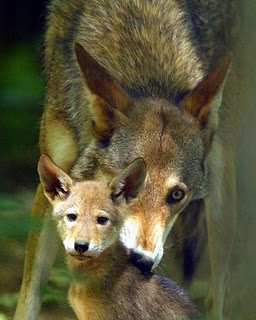
Many of the posts on our blog have dealt in one way or another with red wolves. Keeper Marilyn has written a detailed series on the plight of the species and the efforts to reestablish it to the wild in North Carolina. Over the last 20 years the eastern North Carolina population has increased dramatically and has become a textbook example of reintroducing an extirpated species.
Unfortunately, the only wild population of red wolves has been threatened by one of the largest wildfires in recent North Carolina history. The NC Division of Forest Resources reports that the fire has burned over 40,000 acres (16,200 hectares). Thankfully, the red wolf population appears to have escaped immediate harm but long-term ecosystem effects are still a concern.
We often think of the extinction of a species like a murder: some event or action leads to the demise of the group. For instance, you may have heard someone say that an asteroid killed the dinosaurs or global warming will wipe out polar bears. While these statements might be useful sound bites, they obscure more complicated stories that should be considered.
If you are interested in learning more about how complex interactions between environmental and physiological stresses can affect an already threatened species try reading about the catastrophic declines in Lion populations in the 1990’s in Africa. In short, epidemics of disease combined with stress from local climate changes created high mortality rates in affected populations. A disease that was widespread but rarely fatal became much more dangerous when blood-born parasites were present and droughts occurred.
A great summary of the research can be found at the Not Exactly Rocket Science blog
and the full article is at PLOS.
Is there a remote possibility of the wolves that have been reintroduced near the coast making their way to Durham County? The reason I ask is because a couple of weeks ago while driving down Scott Mann Road (Southern edge of the county) I witnessed a creature crossing the road that was certainly not a deer but looked a lot like a coyote. The only problem was that it was far too large to be a coyote. It may have been a dog but it looked like a wolf and moved like a wolf.
The red wolves of eastern North Carolina are very closely monitored and it seems impossible that one could be this far west. Coyotes have become increasingly common in NC in the past few years. You say it was far too large to be a coyote but I’m not sure what your standards are. Larger coyotes would be almost the same size as red wolves and they can be very difficult to tell apart from a distance. Coyotes can reach 40-45 pounds and the largest one on record is over 70 pounds.So while it is not impossible for your sighting to be a wolf, the odds are great that you saw a biggish coyote. Thanks for your question.